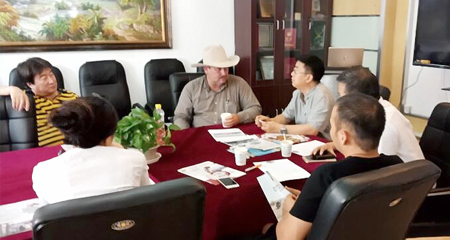The State Council, the Chinese equivalent of cabinet, last week gave the go ahead for China to run down its $US3 trillion ($3.9 trillion) of foreign exchange holdings to buy directly into major international infrastructure projects and ramp up exports of heavy machinery.
Most of the country’s forex reserves are held in low-yielding US Treasury reserves and China has been under pressure to diversify its holdings.
The Chinese government will give subsidies to large industrial machinery manufacturers to send products overseas to work on developments.
The Chinese government did not specify where the increased government investment would be directed, but China experts said it was likely a large portion of the money would be spent in Australia, after a free-trade agreement was signed between the two countries.
Qinghua University economics director He Maochun said it was increasingly likely China would look overseas to Australia to ramp up foreign investment.
The Coalition government has set a more favourable agenda towards overseas investment, which is believed to have encouraged the Chinese government.
The two-way trade between Australia and China is estimated to be worth at least $US130 billion a year, primarily though commodities. “The strategy is a positive sign to Australia,” Professor He told The Australian.
Professor He said China was well placed to channel investment into Australia as the Coalition aimed to fast-track major infrastructure developments. The FTA is expected to open more exports into China aside from mining. The dairy industry is likely to be the major beneficiary, as tariffs on key products are gradually reduced.
“China can provide capital, producing capacity and equipment to help Australia optimise its economic structure,” he said.
“China also needs agriculture products, mechanism as well as environmental protection technology from Australia.
“In the long-term, the two sides could build up a closer and freer trade relationship.”
HSBC Australia’s China desk leader, Leon Li, said Australian and Chinese corporates were looking to invest in each other’s countries, especially after the FTA, signed last year.
“We are seeing increasing interest from Chinese investors, particularly in Australian ports, roads, mining and power infrastructure,” he said. “In Australia, they see the combination of significant investment opportunities, a stable political environment, a mature legal system and sustainable investment returns relative to other markets.”
Corrs Chambers Westgarth partner and China business group co-chairman Andrew Lumsden said there was a “high level of interest” out of China for Australian infrastructure projects.
He said a significant number of investors believed Australia could serve as a “test bed” for delivering social infrastructure projects. However, Chinese investors were well aware of a “very competitive market” for infrastructure financing, acquisition and construction in Australia.
“Obviously the relative performance of the currency is a major issue in long-term, low-yield assets. That means you’ve got to take a view about the Australian dollar long-term and the views on that are as mixed and varied as there are people in China,” Mr Lumsden said.
Bank of America Merrill Lynch chief economist Saul Eslake said infrastructure “requires a lot of capital and the Chinese have got a lot of it”.
“You would think there is a lot of infrastructure investment required in Australia and some indications that governments want it done in ways that don’t involve government borrowing.
“It’s not unreasonable to think that the Chinese would think there are opportunities here.”
Mr Eslake said there was an “unresolved” issue about the extent to which Foreign Investment Review Board vetting was required for investments by state-owned enterprises. Under the FTA, the issue of FIRB review of investments by SOEs will be reviewed in three years.
He said there could be “popular opposition — that is, unease in the community to selling what some people might portray as vital infrastructure to the Chinese”.
Infrastructure Partnerships Australia CEO Brendan Lyon said China was a “very attractive partner”. This was because of the move to trade liberalisation, the government’s “clear statements about an appetite for Chinese investment”, the scale of projects that needed to be delivered and privatisations.
“If you look at the pace, scale and innovation of China’s rollout of metro systems in it major capitals, its high-speed rail network and its massive urban redevelopment project, it’s clear China’s got both experience and significant intellectual property that can be applied to our benefit here in
Australia,” Mr Lyon said.
“If we are able to clearly outline the opportunity, then we should be able to see significant competition from Chinese investors alongside European and North American investment, and that can only be to our benefit.”
He said as the proposed privatisations and new projects were of a “very high” quality and would be attractive to China’s private investors and state-owned enterprises, specific incentives would not be needed.
